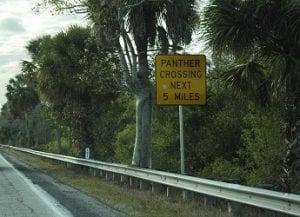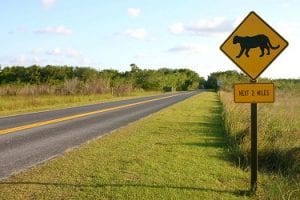UCF Biologists’ RAD Research
In a recent blog post featured by NPR’s ‘Car Talk,’ Kieran Lindsey, Ph.D., highlights a UCF Department of Biology research team’s mission to determine the effectiveness of linking Roadside Animal Detection Systems (RADS) with various types of warning signs. This research team includes biology doctoral student Molly Grace, Pegasus Professor Reed Noss, Ph.D., and Research Associate Daniel Smith, Ph.D.
If you were driving through Florida’s Big Cypress National Park, which sign would be more likely to make you hit the brakes?
This…

Courtesy of Car Talk.
or this?

Courtesy of Car Talk
This isn’t a purely hypothetical question—a research team from the University of Central Florida really wanted to know.
UCF Biology Ph.D. candidate Molly Grace, Reed Noss, Ph.D., and Daniel Smith, Ph.D., of the UCF Department of Biology in the College of Sciences, teamed with the university’s Institute for Simulation and Training to investigate the effectiveness of combining Roadside Animal Detection Systems (RADS) and various types of warning signage.
RADS, which employ either radar or lasers, have been used and studied since the 1990s but the installations are not identical. The UCF team wanted to reduce the number of confounding variables such as road design, species of interest, and how the warning is conveyed.
To learn more about the team’s findings, read the rest of Kieran Lindsey’s ‘Picture Panthers: Can Better Signage Get Drivers to Brake for Wildlife?’ article, here.
